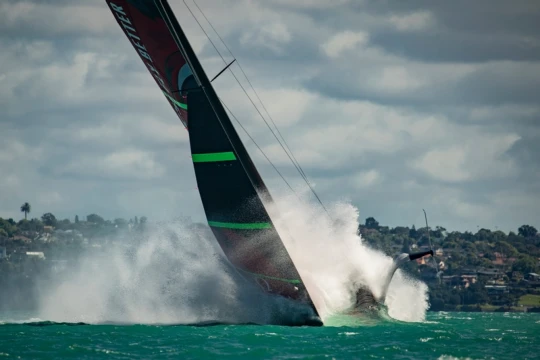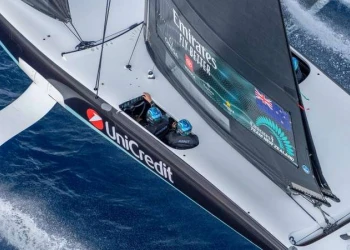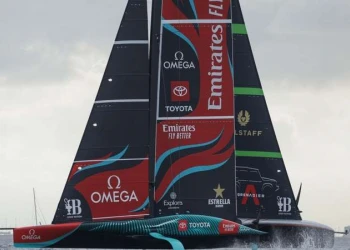
TE REHUTAI NOSEDIVE JANUARY 2021 (CREDIT / DYLAN CLARKE)
Emirates Team New Zealand, AC40: implementing the solution
Just days ago, Emirates Team New Zealand buried the bow of their AC40 while testing in waves on Auckland's Hauraki Gulf, which resulted in damage to the forward sections of the hull and deck structure. While the on-water team was recovering the yacht and returning to dock, the team's engineers immediately began reviewing onboard data to identify the root cause of the issue.
"The first things we look at in this type of dynamic event are the accelerations and rotation rates that come from yacht's inertial measurement unit (IMU)," explained Jamie Timms, Emirates Team New Zealand Structural Engineer. "These readings allow us to infer the magnitude of the hydrodynamic loads on the hull structure, which we can then input into our structural simulations to estimate the stress state and structural margins of safety. We also use the data to validate our fluid dynamics simulations of high velocity hull impacts."
"During the 36th America's Cup, we captured and catalogued the dynamics of every major event across the three yachts we sailed in that campaign and we enveloped those, with additional margin, to define the load cases for the AC40. Over the first 18 days of sailing the AC40, we'd seen a couple of events that generated large impacts. These had been lining up with our design load cases and the hull structure was performing as expected. However, this latest event saw accelerations that were far beyond all our previous records."

"The figures below compare the longitudinal and lateral decelerations from the AC40 crash against the largest event seen by Te Rehutai, the team's AC75 from the last America's Cup (pictured above). "Not only did we see longitudinal decelerations 70% higher than the previous worst-case, but this was coupled with a simultaneous lateral loading of similar magnitude - the yacht came to a complete stop and yawed 90 degrees in just over a second. We believe it was this combined load state that led to an initial failure of the foredeck sandwich panel. The damage we saw in the hull and partial detachment of the bow structure is likely a consequence of the compromised deck panel, rather than a root cause."
With this new data in hand, the team's engineers have designed an internal structure upgrade package that will be rolled into all current and future AC40 yachts.
"Throughout the development of this class, we've seen the yachts become increasingly dynamic as the performance of the yacht and the skills of the sailors grows. As with any high-performance craft, there is a constant balance between reducing mass and ensuring reliability and safety, and as our understanding of the class grows, we evolve our approach to maintain that balance. This additional structure will restore full structural margins for the uprated load cases and allow the sailors to push the performance limits of the class safely and with confidence."

The internal structure upgrade package will be built by McConaghy's, who are building the fleet of AC40's.
"The good news is there will be no change to the delivery schedule to the remaining AC40s currently in build and the bow upgrade package will be shortly sent from the McConaghy yard for retro fitting to the three AC40s that have already been delivered."





